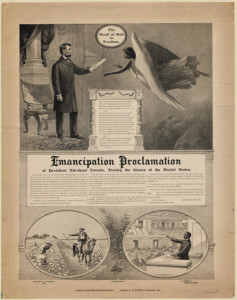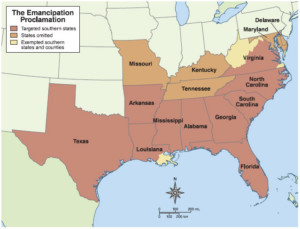President Abraham Lincoln issued the Emancipation Proclamation on January 1, 1863, as the nation approached its third year of bloody civil war. The proclamation declared “that all persons held as slaves” within the rebellious states “are, and henceforward shall be free.”
(click images to enlarge)
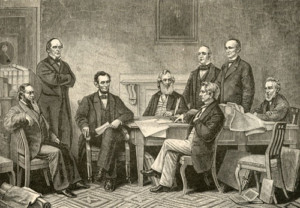 President Lincoln read the first draft of this document to his Cabinet members on July 22, 1862. After some changes, he issued the preliminary version on September 22, which specified that the final document would take effect January 1, 1863. Slaves in Confederate states which were not back in the Union by then would be free, but slaves in the Border States were not affected. The president knew the proclamation was a temporary military measure and only Congress could remove slavery permanently, but had the satisfaction of seeing the 13th Amendment, which abolished slavery, pass a few months before his death.
President Lincoln read the first draft of this document to his Cabinet members on July 22, 1862. After some changes, he issued the preliminary version on September 22, which specified that the final document would take effect January 1, 1863. Slaves in Confederate states which were not back in the Union by then would be free, but slaves in the Border States were not affected. The president knew the proclamation was a temporary military measure and only Congress could remove slavery permanently, but had the satisfaction of seeing the 13th Amendment, which abolished slavery, pass a few months before his death.
The most controversial document in Lincoln’s presidency, its signing met with both hostility and jubilation in the North. After the preliminary version was made public, Lincoln noted, “It is six days old, and while commendation in newspapers and by distinguished individuals is all that a vain man could wish, the stocks have declined, and troops come forward more slowly than ever. This, looked soberly in the face, is not very satisfactory.” However, on the day he approved the final version, Lincoln remarked, “I never, in my life, felt more certain that I was doing right, than I do in signing this paper.” (more)
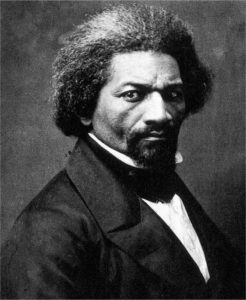 Although President Lincoln is sometimes credited with freeing enslaved African Americans with the signing of his Emancipation Proclamation, this event was possible thanks to the writings, demonstrations and work of many abolitionists. Frederick Douglass is perhaps the most recognized abolitionist of the antebellum period. In his last autobiography, Life and Times of Frederick Douglass, Douglass noted that Lincoln considered him a friend, although at times Douglass was critical of the late president.
Although President Lincoln is sometimes credited with freeing enslaved African Americans with the signing of his Emancipation Proclamation, this event was possible thanks to the writings, demonstrations and work of many abolitionists. Frederick Douglass is perhaps the most recognized abolitionist of the antebellum period. In his last autobiography, Life and Times of Frederick Douglass, Douglass noted that Lincoln considered him a friend, although at times Douglass was critical of the late president.
Lincoln honored Douglass with three invitations to the White House, including an invitation to Lincoln’s second inauguration. During his first visit, Douglass petitioned Lincoln to pay African American Union soldiers as much as their white counterparts. Lincoln answered that African American soldiers would get their fair wages when the time was right, which frustrated Douglass, although he came to understand Lincoln’s reasoning. (more)
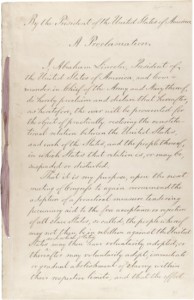 President Lincoln issued the preliminary Emancipation Proclamation in the midst of the Civil War, announcing on September 22, 1862, that if the rebels did not end the fighting and rejoin the Union by January 1, 1863, all slaves in the rebellious states would be free.
President Lincoln issued the preliminary Emancipation Proclamation in the midst of the Civil War, announcing on September 22, 1862, that if the rebels did not end the fighting and rejoin the Union by January 1, 1863, all slaves in the rebellious states would be free.
The Confederate Army did not concede and three months later, on the Emancipation Proclamation was issued.
At the time, it was thought of as an effective war measure that would cripple the Confederacy, which had used enslaved laborers to support the Confederate Army. However, the Emancipation also set the stage for conversations on the future of human bondage in the United States and would dramatically alter the lives of African Americans once the Civil War ended. (more)
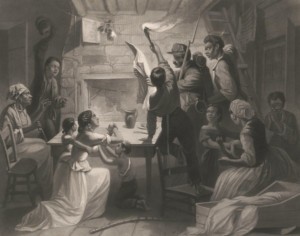 On January 1, 1863, President Abraham Lincoln issued the Emancipation Proclamation freeing three quarters of the slaves in the United States. However, the proclamation only freed those slaves in rebel states. To attain freedom, slaves still had to escape to the Union. In this image, a Union soldier reads the proclamation to anxious slaves.
On January 1, 1863, President Abraham Lincoln issued the Emancipation Proclamation freeing three quarters of the slaves in the United States. However, the proclamation only freed those slaves in rebel states. To attain freedom, slaves still had to escape to the Union. In this image, a Union soldier reads the proclamation to anxious slaves.
Although the Emancipation Proclamation did not end slavery in the nation, it captured the hearts and imagination of millions of Americans and fundamentally transformed the character of the war. After January 1, 1863, every advance of federal troops expanded the domain of freedom. Moreover, the Proclamation announced the acceptance of black men into the Union Army and Navy, enabling the liberated to become liberators. By the end of the war, almost 200,000 black soldiers and sailors had fought for the Union and freedom. (more)
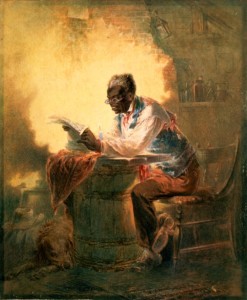
Black man reading newspaper by candlelight. Headline says, “Presidential Proclamation, Slavery,” which refers to the Jan. 1863 Emancipation Proclamation. (Library of Congress)

